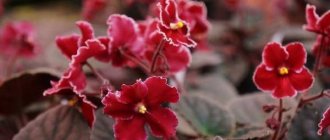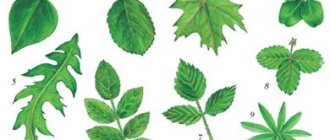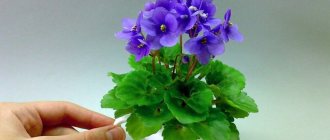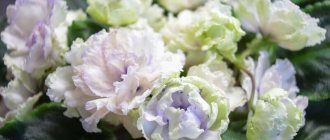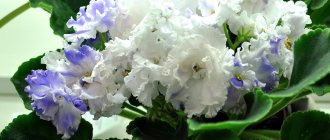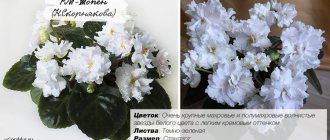Flower growers usually do not give preference to one color - each flower is good in its own way. Many “violet growers” love purple violets; it combines red and blue colors. They say that purple is the color of wisdom and spirituality. It is loved by intellectual people, poets and philosophers. This noble color helps to establish harmony between people, spiritual kinship and mutual understanding. There are so many varieties of purple violets that it is simply impossible to write about them in one article. Therefore, for now we will only talk about five beauties. More on the rest a little later.
Violet Baltika
The delicate blue-violet flower belongs to the semi-double species of the Gesneriaceae-Saintpaulia family. The tips of the wavy leaves are jagged, with a gradient white edge that looks very impressive. Rosette of light rich green color. Baltika violet is a large, compact flower, with wide leaves that create a voluminous “foamy cloud”.
Energy of color
Many florists are attracted to lilac plants, the color obtained by merging two colors - red and blue.
The color lilac is considered a living color, but psychological experts believe that its shades cause a feeling of anxiety.
People who have a negative attitude towards lilac shades are extremely lucky in the field of business, because this color is preferred by individuals who avoid a specific answer and do not know how to maintain an open dialogue. The favorite pastime of individuals who prefer lilac tones to others is nostalgia for the past, and this is a direct road to nowhere. Each color is capable of a certain energy and it would be a sin not to use it.
Violet Currant dessert
The color of the leaves is real blackcurrant jam! Violet Currant dessert is a semi-double variety. Beautiful, rather large leaves are velvety, with green edges turning into light pink. Flower growers advise beginners to start with this fluffy violet, because it is completely unpretentious, despite all its beauty.
Types and varieties of Saintpaulia, description of indoor plant
All violets were divided into several groups to facilitate orientation among the many species. There are three groups :
- collectible;
- variegated;
- industrial.
Variegated varieties are characterized by the brightest color of the leaves, which can be painted in different colors . They often have a border around the edges. The first variegated varieties produced small and simple inflorescences, but later breeders developed species distinguished by large double flowers of different colors.
Industrial Dutch violet
Industrial - intended for mass cultivation on special plantations . They are available for purchase in large quantities. Their appearance is the simplest. These plants are mainly used to decorate banquet halls and are placed in offices and government institutions. These varieties bloom actively for a long time.
They require minimal care, so they are often grown at home.
Collectible
They are characterized by large inflorescences measuring from five to seven centimeters. They differ from other species in that almost all of them have large double petals of a wavy shape, painted in a wide range of colors : from snow-white to rich blue shades. The leaves also vary in color and have wavy edges.
Violets of these varieties are collected by collectors and shown at exhibitions.
The most beautiful and unusual varieties are collected at exhibitions. Complex collectible varieties require more time and effort to successfully grow and properly care for. Labor is rewarded with gorgeous flowering. Collectible violets include : Lemon Snow, Willodene, Gift for a Loved One and many others.
Turquoise jellyfish
Family - Gesneriaceae-Saintpaulia. More turquoise than purple, the leaves are double and fluffy, and can grow up to 7-8cm in diameter. The soft green rosette is compact and creates a “complete” picture. Violet Turquoise jellyfish always blooms in a “cap”; its flower stalks do not stretch out. It blooms often and profusely, but does not like heat.
Recommendations for planting and care
Violets are indoor plants. Comfortable temperature is 20-25 ℃. Exposure to scorching sunlight and drafts is contraindicated. But in general the plant is light-loving. The air is humidified to 50-60%. EK Courage-violet is grown in pots.
Difficulties in caring for the plant:
- Provide a sufficient degree of air humidification.
- Avoid overcooling the root system when growing on a windowsill in winter.
- Provide suitable air temperature.
Winter rose
Dark purple flower buds, similar to roses, with snow-white edges. Violet Winter Rose is considered an industrial variety. It is easy to care for, it is unpretentious and easily gets along in any room. The shoots of the plant are numerous, branching, shortened, and the “buds” are large, creating a lush head. The leaves are dark green, lighter on the inside. Winter rose loves moisture, but it cannot be sprayed. You can get out of the situation by simply placing a container of water next to it.
Features of reproduction
The method of propagation by leaf cuttings (rooting in water) is often used. The leaves are cut from the mother plant, rooted (from 2 weeks to 1 month), covered with a bag. Carry out careful drip irrigation. After rooting, replant.
Additional Information! Using a similar scheme, leaf cuttings are rooted in a substrate (perlite and soil mixture 3:1). The method is suitable for not very high-quality planting material.
When propagating violets, the planting procedure is carried out when shoots with a diameter of up to 5 cm appear at the base of the cuttings. If it is not possible to purchase a ready-made substrate, prepare the soil for planting yourself. To do this, mix peat, river sand, leaf debris, perlite or special moss in equal proportions.
Midnight Velvet (Sorano)
Midnight Velvet (Sorano), as the name of this violet sounds in English, has strong leaves stretching upward. Velvet dark blue flowers shimmer with a purple tint. The thin white border on the leaves emphasizes the beauty of the plant, which is truly very impressive! Although the flowers are small, there are many of them and they delight their owners with long-lasting flowering. The variety reproduces easily and loves cool, bright rooms. Don't be scared by the first flowering - the violets will look like pansies. But next time the Midnight Velvet violet will delight you with its terry miracle.
home
Uzambara violet.
Family Gesneriaceae - Gesneriaceae.
Genus Saintpaulia hybrida - Hybrid Saintpaulia.
African violet saintpaulia hybrid.
My name is Vladimir, I am not a collector, but a lover of violets. I do not sell leaves and violets, but buy from collectors and grow them for myself
This site is created on 2929 pages for lovers of indoor flowers. For those who keep a small collection on and around their windowsills. In total, there are 4,731 varieties of violets on the site; descriptions of care, maintenance and propagation are given for 2,026 varieties of violets. Diseases of violets, their diagnosis and treatment methods are described. Descriptions and care for 283 types of indoor plants are given. This information is complemented by 1639 videos. The site will be constantly updated with changes and new materials.
Violets are very often called the queens of window sills, because not a single indoor plant decorates a room as much as a well-groomed violet with abundant flowering. They have gained wide popularity among flower growers due to their unpretentiousness. Saintpaulia is one of the few indoor plants that can bloom all year round, even only under artificial light.
When I started buying violets, I encountered great difficulties in obtaining information on specific varieties of violets. Mainly websites and pages of leaf and baby sellers, where the official description of the breeder is rewritten... and that’s all! How does this particular violet grow, what kind of rosette, will it fit on my windowsill, are the flowers fallen, are the flower stalks recumbent, can it tolerate bright light? And if he gets sick, how to identify and how to treat? And a lot of questions for a novice collector! Time passes, violets die from improper maintenance and care, the desire comes to stop wasting money, because... This is not yours.
You buy an adult violet, it still looks quite healthy, the leaves have not lost turgor, there are many flower stalks with unopened buds, but it turns out that the roots are already damaged and after a while it becomes noticeable that the plant is dying. It turns out that when buying an adult plant, you must look at the roots. Living roots are white or light brown, while dead roots are dark brown and black. In any case, it should be remembered that it is important for the seller to sell, and then at least the violet does not grow, in the literal sense.
On the forums, the material is scattered, collectors often contradict each other, and for the most part you can find out - I want what I want, - I’m eating!, - what a beauty, - so neat (and in the photo the leaves are as big as the palm of your hand, the petioles are like the spokes of a bicycle), - Thank you, Thank you, - and below - Visit my store, - Girls, tell me what is the size of the socket, features in growing? And in 80% of cases the answer is silence.
On the same forum, they can start discussing for 10 pages whether this violet is similar to another, and they often insert photographs of both violets, without indicating the name. They, as experienced collectors, understand which is which, but for us this brings a misunderstanding of the variety.
Although breeders (especially in CIS countries) call such colors that you become stunned, what color is it? Moreover, several of these colors are present on one flower, along the edge, in the center, strokes, prints, strokes, etc. It seems that breeders specifically use these color names to indicate the virtual color of the violet. Take pencils and try to draw or visualize these colors. How exactly do they differ? Only 24 flower colors have been selected here, how many can you guess without special literature? Compare with photos of violets.
Soft lilac-purple; Purple-violet; Dark purple-violet; Smoky lilac; Pastel lilac with a lilac tint; Dark cherry inky; Ash cherry; Cherry purple; Raspberry-purple-lilac; Burgundy-raspberry-fuchsia; Burgundy-lilac; Black and burgundy; Lilac-brown; Pink orchid; Pinkish yellow; Hot carmine pink; Golden-light green; Green-golden; Yellow-green; Amethyst; Orchid; Coral; Fuchsia; Emerald;
There are collectors who write about what they encountered when growing a particular variety of violets, but, unfortunately, there are not many of them. I wanted to help summarize all the material on growing violets for hobbyists with a small collection, for whom flowers are for decorating their apartment and soul, and not a business and a source of funds.
Listen to the advice of collectors on the forums:
Ashka, Elen, Evgenika, Flora, HappyFeet, Ki-vi, mandragora, Margo_Shastic; Me-Lena, Mishonet, Passific, Petrovich, Raisa, Red fox, Ulmo, Yalo, Alchemist, Alyonushka, Anatolyevna, Julia, Elena M, Zybinova Ekaterina, Lyutsina, Ball, Natalka, Bee, Raisa Litvinova, rush, Svetlana Sazykina; Svetlana40, Tatyana Lysikova, Fialochka_23; Master of the Garden; Julia (Dnepr);
I tried to select photographs as close as possible to the description of the variety by the breeder. Bit by bit he collected and summarized the experience of serious collectors. The site is currently in a dynamic stage of development, updates are constantly appearing, and articles are being added to. I want the site to serve as a source of information for those who have just begun their journey into this wonderful world, for those who have a small collection of violets. It is expected that new descriptions, photographs, secrets of successful content, and tips for beginners will be constantly added.
